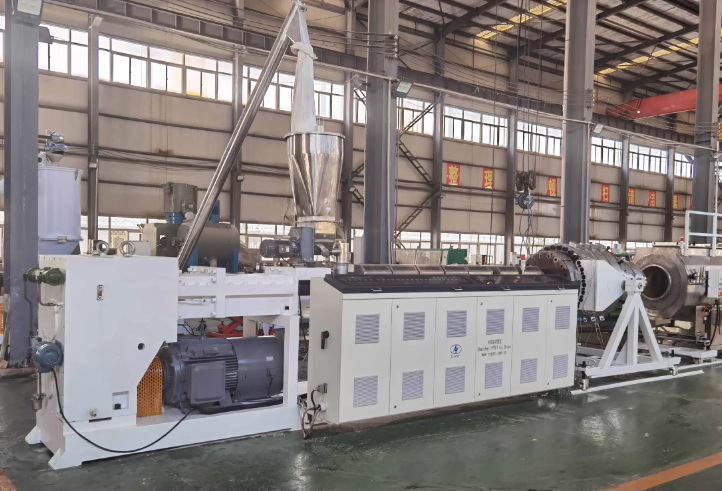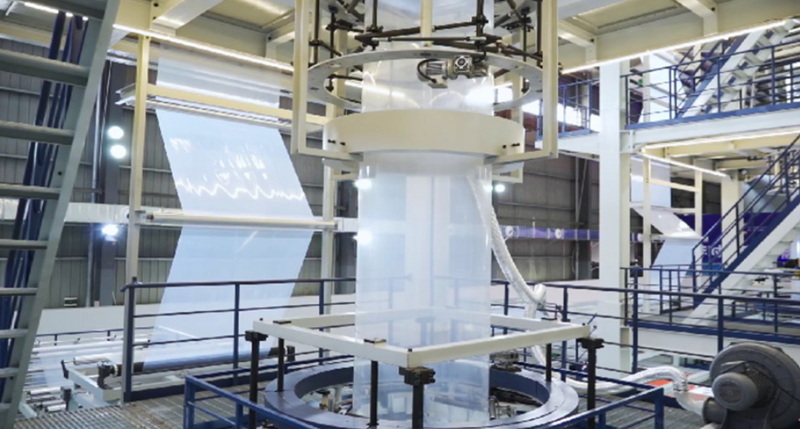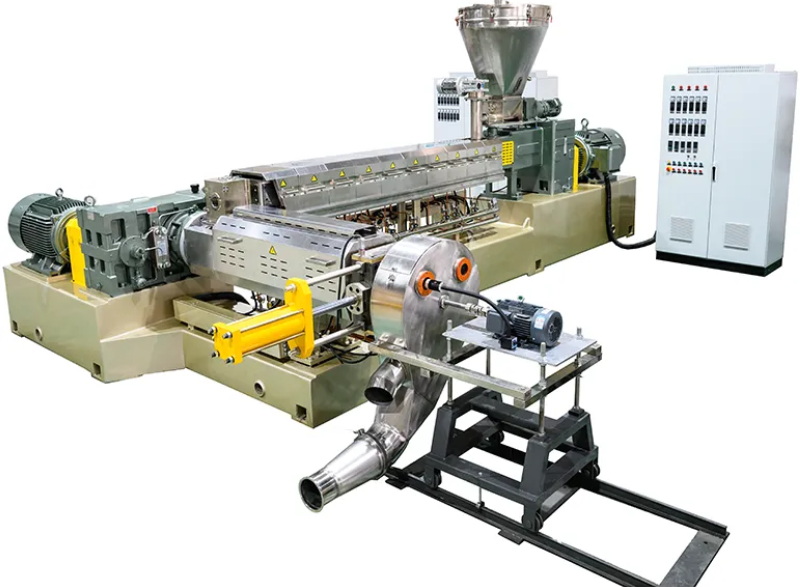Content Menu
● Introduction to Plastic Extrusion Machinery
>> Components of Plastic Extrusion Machinery
● Key Factors to Consider When Buying Plastic Extrusion Machinery for Sale
>> 1. Machine Type and Size
>> 2. Material Compatibility
>> 3. Production Capacity
>> 4. Quality and Precision
>> 5. Energy Efficiency
● Types of Plastic Extrusion Machinery for Sale
>> Single Screw vs. Twin Screw Extruders
>> Specialized Extrusion Machines
● Customizable Features in Plastic Extrusion Machinery for Sale
>> Screw Design
>> Die Design
>> Heating and Cooling Systems
>> Control Systems
● Downstream Equipment in Plastic Extrusion
● Choosing the Right Plastic Extrusion Machinery for Sale
● Maintenance and Upkeep of Plastic Extrusion Machinery
● Future Trends in Plastic Extrusion Machinery
● Conclusion
● FAQs
>> 1. What is the primary function of plastic extrusion machinery?
>> 2. How do I choose between single screw and twin screw extruders?
>> 3. What are the key factors to consider when buying plastic extrusion machinery for sale?
>> 4. What are the benefits of using energy-efficient plastic extrusion machinery?
>> 5. How important is supplier reputation when purchasing plastic extrusion machinery for sale?
Plastic extrusion machinery is a crucial component in the manufacturing of various plastic products, including pipes, profiles, sheets, and films. The process involves melting raw plastic material and forcing it through a die to create the desired shape. When purchasing plastic extrusion machinery for sale, several factors must be considered to ensure that the equipment meets your production needs and budget. This article will guide you through the key considerations and provide insights into the types of plastic extrusion machinery available.

Introduction to Plastic Extrusion Machinery
Plastic extrusion machinery is designed to transform raw plastic materials into continuous profiles. The process begins with feeding plastic pellets into a hopper, which then moves into the extruder's barrel. Inside the barrel, a rotating screw melts the plastic through heat and mechanical friction. The molten plastic is then forced through a die, which shapes it into the desired form. The extruded product is cooled and solidified, often using water or air, and then cut into the required lengths.
Components of Plastic Extrusion Machinery
A typical plastic extrusion machine consists of several key components:
- Hopper: Where raw plastic material is loaded.
- Barrel: Houses the extruder screw and is equipped with heaters.
- Extruder Screw: Pushes the plastic forward, melting it through friction and heat.
- Die: Shapes the molten plastic into the final product.
- Cooling System: Cools the extruded product to solidify it.
- Cutter: Cuts the extruded product into desired lengths.
Key Factors to Consider When Buying Plastic Extrusion Machinery for Sale
1. Machine Type and Size
The type and size of the machine should align with your production volume and space constraints. Different machines are optimized for specific products, such as pipes, profiles, or films. For instance, pipe extruders are designed with specialized dies to produce uniform tubes, while profile extruders can create complex shapes like window frames.
2. Material Compatibility
Ensure the machine can handle the specific materials you plan to use. Different plastics have unique properties that require specialized machinery. For example, PVC (polyvinyl chloride) requires precise temperature control to prevent degradation, whereas HDPE (high-density polyethylene) needs machinery that can handle its high melting point.
3. Production Capacity
Assess the machine's output in terms of volume and speed. Higher capacity machines are generally more efficient but may require a larger investment. It's essential to balance production needs with budget constraints to maximize ROI (Return on Investment).
4. Quality and Precision
Look for machines with advanced control systems for higher precision. The precision of the machine affects the quality of the final product. Modern extruders often feature digital controls that allow for precise temperature and speed adjustments, ensuring consistent product quality.
5. Energy Efficiency
Opt for energy-efficient machines to reduce operational costs. Modern machines often feature advanced heating systems and variable speed drives that minimize energy consumption. Energy efficiency not only saves costs but also aligns with sustainability goals.

Types of Plastic Extrusion Machinery for Sale
Single Screw vs. Twin Screw Extruders
- Single Screw Extruders: Simple, cost-effective, and suitable for basic applications. They are ideal for processing materials like PVC and PE.
- Twin Screw Extruders: Offer better mixing and processing capabilities, ideal for complex materials such as filled or reinforced plastics. Twin screw extruders provide superior homogenization and are often used in compounding applications.
Specialized Extrusion Machines
- PVC Extruders: Designed for polyvinyl chloride, maintaining precise temperature control to prevent degradation.
- HDPE Extruders: Engineered for high-density polyethylene, handling its high melting point and ensuring consistent product quality.
- PET Extruders: Manage polyethylene terephthalate's crystallinity for optimal quality, often used in bottle production.
Customizable Features in Plastic Extrusion Machinery for Sale
Screw Design
The screw can be tailored to enhance processing capabilities and product quality. Different screw designs optimize the melting and mixing of various plastic materials.
Die Design
Customizable dies allow for specific product shapes and dimensions. This flexibility is crucial for producing complex profiles or specialized products.
Heating and Cooling Systems
Optimized for consistent processing conditions, these systems ensure that the plastic is melted uniformly and cooled efficiently.
Control Systems
Advanced systems facilitate remote operation and real-time monitoring, allowing for precise adjustments during production.
Downstream Equipment in Plastic Extrusion
Downstream equipment includes cooling tanks, pullers, cutters, and winders, which are essential for finishing the extruded products. Cooling tanks help solidify the product, while pullers maintain tension to prevent sagging. Cutters trim the product to the desired length, and winders roll up the finished product for storage or further processing.
Choosing the Right Plastic Extrusion Machinery for Sale
When selecting plastic extrusion machinery, consider the type of plastic material, production capacity, machine size, energy efficiency, maintenance requirements, and supplier reputation. A reputable supplier provides excellent customer service, on-time delivery, and post-purchase support, which are crucial for maintaining operational efficiency.
Maintenance and Upkeep of Plastic Extrusion Machinery
Regular maintenance is essential to extend the lifespan of the machinery and ensure consistent production quality. This includes cleaning the machine regularly, checking for wear on moving parts, and performing routine repairs. Proper maintenance also helps reduce downtime and operational costs.
Future Trends in Plastic Extrusion Machinery
The future of plastic extrusion machinery is moving towards more sustainable and efficient technologies. This includes the use of recycled materials, advanced recycling technologies, and machinery designed to minimize waste. Additionally, there is a growing focus on digitalization, with machines integrating more advanced control systems and IoT (Internet of Things) technologies to enhance monitoring and optimization.
Conclusion
Purchasing plastic extrusion machinery for sale requires careful consideration of several factors to ensure that the equipment meets your production needs and budget. By understanding the different types of machinery available and their customizable features, you can optimize your manufacturing process and improve product quality. Whether you are producing pipes, profiles, or films, selecting the right machinery is crucial for achieving efficiency and profitability in your operations.

FAQs
1. What is the primary function of plastic extrusion machinery?
Plastic extrusion machinery transforms raw plastic materials into continuous profiles by melting the plastic and forcing it through a die.
2. How do I choose between single screw and twin screw extruders?
Choose single screw extruders for basic applications and twin screw extruders for complex materials requiring better mixing and processing capabilities.
3. What are the key factors to consider when buying plastic extrusion machinery for sale?
Key factors include machine type and size, material compatibility, production capacity, quality and precision, and energy efficiency.
4. What are the benefits of using energy-efficient plastic extrusion machinery?
Energy-efficient machines reduce operational costs and align with sustainability goals, offering long-term savings.
5. How important is supplier reputation when purchasing plastic extrusion machinery for sale?
A reputable supplier provides excellent customer service, on-time delivery, and post-purchase support, which are crucial for maintaining operational efficiency.






















